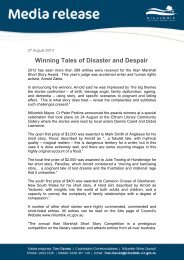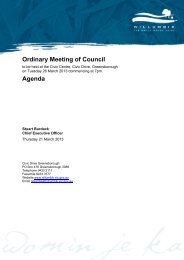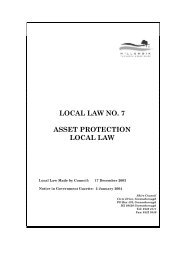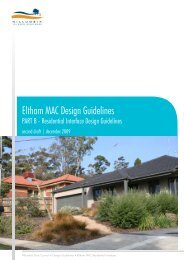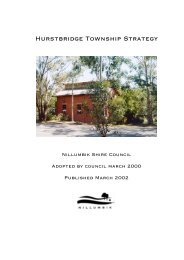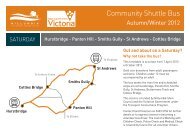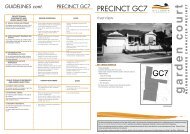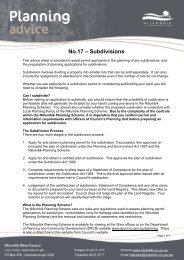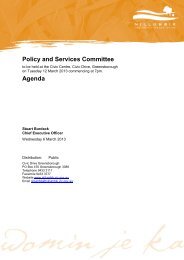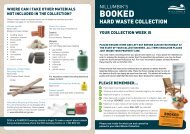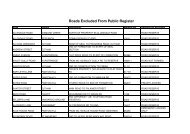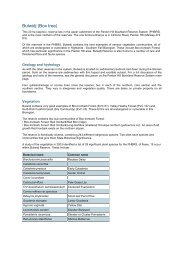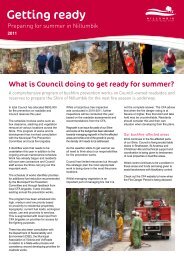Municipal Fire Management Plan 2013â2016 - Nillumbik Shire ...
Municipal Fire Management Plan 2013â2016 - Nillumbik Shire ...
Municipal Fire Management Plan 2013â2016 - Nillumbik Shire ...
You also want an ePaper? Increase the reach of your titles
YUMPU automatically turns print PDFs into web optimized ePapers that Google loves.
APPENDIX EMETHODOLOGY FOR PRIORITISING WORKS ON ROADSIDESPriority/Fuel Modified RoadsidesThis Appendix outlines fire prevention works that are carried out on roadsides across the municipalityon both identified Priority and Fuel Modified Roadsides. The relevant authority for these roads iseither Council or VicRoads. Both agencies have responsibility under the CFA Act to prevent fires onroadsides and to contain roadside fires. <strong>Management</strong> of vegetation on roadsides for fire across themunicipality is a complex issue and needs to address a number of issues which include:What risk(s) are we trying to manage?Will the fuel modification treatment actually mitigate these risk(s)?What are the best fuel management techniques available?What is the cost of the treatment(s) and is it justifiable?Are there better ways of managing the threat?Are the treatments in line with identified Priority Roads?In order to maintain CFA‘s position as a key stakeholder on land management issues, it is vital thatfire brigades have robust processes for the development of long term fire management strategies.This ensures that the actions are appropriate, effective, justifiable and sustainable. The keyconsiderations in this process are:consistent assessment criteria across the <strong>Shire</strong>;focused locally;based on sound procedures which consider local needs and community expectations.As part of the identification of a Road, vegetation levels must also be considered. In this assessment,the elevated and near surface fuels need to be considered as this may result in flame lick thus makingthe road unsafe to the road user.With this in mind, a standard fuel loading of High should be maintained on the identified road as perDSEs Overall Fuel Hazard Assessment Guide, (DSE, 2010).Risk Assessment Process for Priority Roads in <strong>Nillumbik</strong>Priority roads are defined as those roads that if rendered un-trafficable would have the greatestnegative impact on the community. It should be noted that in cases where there are a large numberof trees on both the roadsides and on adjacent private properties that safe access and egress alongroads may not always be achievable and alternative access/egress may need to be investigated.However, generally, Priority Roads will be managed to a higher level in order to reduce these risksand attempt to meet an expectation that they remain open in fire events. Negative impacts include:preventing community members from evacuating a hazardous area; and/orpreventing access and egress of emergency services.Due to the limited funding for works on roadsides, roads that are listed as priority 3 will be consideredfor works as funding becomes available or that all works have been completed on priority 1 and 2roads. It must also be noted that roads that are listed as priority 3 & 4 roads require furtherinformation and justification before assigning any priorityRisk IdentificationThe CFA asked all brigades in the <strong>Shire</strong> of <strong>Nillumbik</strong> to identify priority roads in their area.<strong>Nillumbik</strong> <strong>Municipal</strong> <strong>Fire</strong> <strong>Management</strong> <strong>Plan</strong> 2013-2016 Page 22



